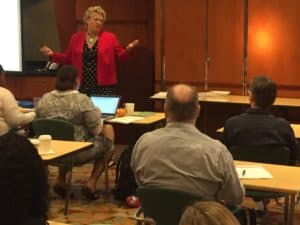Creating and managing a diverse workforce is a process, not a destination.
–R. Roosevelt Thomas Jr., Beyond Race and Gender
The Benefits of Inclusion
As part of my training practice, I lead a workshop entitled “Inspiring a Collaborative and Respectful Work Environment.” During class, I have participants split into groups and answer the following question:
What are the benefits of a work environment in which diversity is valued, differences are respected, and staff members exhibit an inclusive behavior?
Most of my clients offer the same set of responses to this question: “increased creativity,” “improved problem-solving skills,” “a better reflection of our customer and client bases,” “a better representation of the population at large,” and “boosted morale” are just a few of the most common answers. Other benefits mentioned include improved retention rates, increased productivity, better customer relations, and reductions in employee complaints and grievances. In short, because greater diversity can lead to a better understanding of those you work for, with, and around, it can help companies increase their profitability.
 My workshop attendees usually agree that these are all very compelling reasons to support diversity and inclusion, but they often have difficulty articulating exactly what it means to have an inclusive workplace. To help them reach this understanding, I point out that every person present is probably judged on a daily basis: the moment someone walks into a room, people make assumptions about that person based on his or her physical attributes. Then, to underscore this statement, I point to myself and say (with an appropriate sneer on my face):
My workshop attendees usually agree that these are all very compelling reasons to support diversity and inclusion, but they often have difficulty articulating exactly what it means to have an inclusive workplace. To help them reach this understanding, I point out that every person present is probably judged on a daily basis: the moment someone walks into a room, people make assumptions about that person based on his or her physical attributes. Then, to underscore this statement, I point to myself and say (with an appropriate sneer on my face):
- “Her suit’s too dark and conservative for our company.”
- “What’s with her hair? It looks a little crazy and all over the place.”
- “Why doesn’t she have makeup on?” (Or “Boy, she has too much makeup on!”)
- “Her voice is so deep—is she a man?”
- “She has a funny accent.”
I then mention that I know these things are said about me because I’ve read them in after-training surveys (where anonymity can encourage people to be brutal). When I ask my workshop participants how they would feel if someone said those things about them, they typically response with sincere outrage.
The goal of this exercise is to draw attention to the fact that at any moment, someone could be making judgments about each of us that have no relevance to our abilities to do our jobs. We all experience being stereotyped and judged based on a variety of attributes and features (e.g., hairstyle, height, ethnicity) that differ from person to person. And although we are all different, we have one thing in common: at some point in each of our lives, we’ve all probably been judged based on our age. How many of these have you personally encountered?
- “Too young.”
- “Too old.”
- “Not hip enough.”
- “We want someone with more energy.”
- “I don’t want to have to hold someone’s hand—I want someone with more experience.”
 Some time during our professional lives, we’ve probably all been judged and characterized without regard to our knowledge and abilities, because someone made decisions about us based solely on our physical attributes. The point of this workshop exercise is to get people to realize that this sort of thing happens all the time—and that it stinks to be on the receiving end of it. Once that realization sinks in, they understand how important it is, in their own daily management practices, to stop doing this sort of thing themselves.
Some time during our professional lives, we’ve probably all been judged and characterized without regard to our knowledge and abilities, because someone made decisions about us based solely on our physical attributes. The point of this workshop exercise is to get people to realize that this sort of thing happens all the time—and that it stinks to be on the receiving end of it. Once that realization sinks in, they understand how important it is, in their own daily management practices, to stop doing this sort of thing themselves.
Thanks to shifting economic realities and societal expectations, companies need to be more inclusive if they want to maximize their competitiveness in the marketplace. The message is clear: it’s time for managers (and employees) to stop instantly judging others based on their age or other physical characteristics.
Breaking Bad Habits
In his 2005 bestseller Blink: The Power of Thinking without Thinking, Malcolm Gladwell wrote that people hold two levels of attitudes race and gender:
First of all, we have our conscious attitudes, This is what we choose to believe. . . . [O]ur second level of attitude . . . [is] on an unconscious level—the immediate, automatic associations that tumble out before we’ve even had time to think.
Harboring such associations (which also hold true for other physical traits, such as age) is a habit—something that we’ve done repeatedly, usually from childhood. (After all, our attitudes toward different cultures and people are based in large part on our experiences while growing up).
Habits can be hard to shake—but with effort, you can alter them. First, change your inner voice by becoming more aware of your thoughts when you first meet a person. What is the first association that goes through your mind? If it’s negative, figure out what would be a better (and more realistic) association to have. Repeat that process each time you meet new people who share similar traits. Practice by doing some people-watching on a busy street and running the new positive association through your mind as people walk by. Verbalizing such associations can also help solidify them in your mind (although if you’re talking to yourself on a street corner in some cities, don’t be surprised if a police officer stops by to check on you!).
The key to breaking a bad habit is to notice when a negative thought goes through your mind about someone you meet and then immediately replace it with something positive. The more you practice awareness of your thoughts, the better control you will have over them—and eventually you will replace the old habit with a far more productive one.
___________
I hope this discussion so far has piqued your interest in this very current (and very important) topic. Google, with its huge cash reserves and strong market placement, will certainly weather this latest storm just fine, but at Google—and at any organization—there’s always still plenty of room for improvement. Now that you have a sense of how being an inclusive manager can help your company succeed where your competitors fail, tune in in two weeks for suggestions on how to foster inclusivity at your workplace!
Everything you wrote is so relevant and what I experience on a daily basis. I am one of two African American women in management. We are consistently called each others names as if it is okay. I am talked over and my opinion is always negated as not important. I am in charge of a program that I have been doing for over 23 years but new to this work environment. I have been told that before I speak I need to say “I’m new so I might not be right…”. I have been looked over for promotions and told if I work really, really , really hard one day I may be able to move up although I have been a successful in all of my past positions.
Wow, this is REALLY disturbing. Sounds like to me it’s time to find a new company as I’m not sure they appreciate your talents. That would be my advice! Keep us posted and BEST OF LUCK! Val